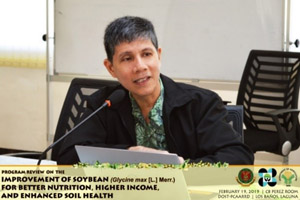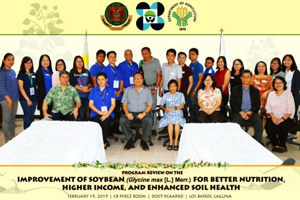 Four projects under the Soybean R&D Program reaped significant deliverables in support of the program’s objectives.
Four projects under the Soybean R&D Program reaped significant deliverables in support of the program’s objectives.
The accomplishments were realized despite the project only nearing its first year.
This was reported by the the Monitoring and Evaluation (M&E) team of the Crops Research Division (CRD) of the Philippine Council for Agriculture, Aquatic and Natural Resources Research and Development of the Department of Science and Technology (DOST-PCAARRD) based on the recently conducted Soybean R&D Program Review at CB Perez Room, DOST-PCAARRD.
Dr. Florentino C. Monsalud, Professor at the University of the Philippines Los Baños (UPLB), and Dr. Liwayway M. Engle, Consultant at Philippine Sugar Research Institute (Philsurin), served as members of the Technical Review and Evaluation Panel (TREP).
Project leaders and staff from the Institute of Plant Breeding (IPB) – University of the Philippines Los Baños (UPLB), Department of Agriculture (DA) – Regional Field Offices 02, 10, 11, and 13; Nueva Vizcaya State University (NVSU); and UPLB College of Economics and Management (CEM) attended the event to present their respective project accomplishments.
Supply Chain Mapping
Supply Chain Mapping of Project 1, titled “Analysis of Supply Chain and Competitiveness, Productivity, and Technical Efficiency of Soybean as Food,” has identified the key customers in the supply chain.
Analysis shows that these customers are into processing of soybean and marketing of soybean-based products such as soymilk, soy coffee, tofu, taho, and raw soybean as material input.
Initial results also showed that the soybean market is concentrated in Metro Manila, Cebu City, and Davao City, which were recorded to be the top consumers and traders of soybean products.
Soybean Production System
On-station trials of soybean production under corn-based and rice-based cropping systems, as well as intercropping with cassava are on-going for Project 2 titled, “Soybean for Higher Income and Enhanced Soil Health under Different Cropping Systems.”
According to Ms. Vanessa Joy F. Calderon of DA-Cagayan Valley Research Center (CVRC), the project is yet to start the comparison of the three cropping systems.
For rice- and corn-based cropping systems, she reported that they still need to wait for a month to harvest the main crop and to start the planting of soybean. Results of the comparison would later suggest which cultural practices help improve productivity and income of soybean farmers in the regions. But for soybean as intercrop with cassava, initial results showed a gross margin of P27,900 per hectare and a soybean yield of 1.8 tons per hectare.
Furthermore, the project has completed gathering of baseline data obtained through assays of the physical, chemical, and biological properties of the soil under different cropping systems. The assessment of impact of soybean production on soil health is currently being initiated.
Identified Challenges
Project 3 titled, “Enhancing the Sustainability of the Informal Soybean Seed Sector,” reported some of the challenges identified by soybean farmers. Included in these challenges were lack of seeds and irrigated areas. Other identified challenges were production inputs, occurrence of natural disasters and pests, low quality of seeds produced, and lack of proper equipment for harvesting.
Meanwhile, ‘Manchuria’ and ‘Tudela’ black varieties have been purified and multiplied, and will be distributed to cooperating farmers. Training materials for farmers’ organization and information guide on seed storability and maintenance of seed genetic purity will be produced in the next year of implementation.
Soybean Variety Development
 For Project 4 titled, “Soybean Variety Development for Large Seed Size, Higher Yields, and Enhanced Functional Properties for Better Nutrition,” the team reported the completion of germplasm collection, characterization, and evaluation. The activity was done to develop populations of soybean with improved characteristics and properties. Hybridization of ‘Tiwala’ 6, 8, 10, and ‘Manchuria’ was likewise accomplished by the project. The project was also able to identify 49 simple sequence repeat (SSR) markers for large size, light hilum color, and total isoflavones for polymorphism.
For Project 4 titled, “Soybean Variety Development for Large Seed Size, Higher Yields, and Enhanced Functional Properties for Better Nutrition,” the team reported the completion of germplasm collection, characterization, and evaluation. The activity was done to develop populations of soybean with improved characteristics and properties. Hybridization of ‘Tiwala’ 6, 8, 10, and ‘Manchuria’ was likewise accomplished by the project. The project was also able to identify 49 simple sequence repeat (SSR) markers for large size, light hilum color, and total isoflavones for polymorphism.
Dr. Engle commended the accomplishments of Project 4 and expressed her appreciation for the effort to build up on previous works on soybean.
Further analyses of the results and more accomplishments are expected to be delivered by the projects as the program continues to operate for another year.
The Soybean R&D Program is one of the initiatives under the Industry Strategic S&T Programs (ISPs) of DOST-PCAARRD for Legumes. It aims to promote higher farm income and more sustainable farming through soybean integration in the cropping system as well as enhanced health and wellness for higher consumption of food soybeans.
